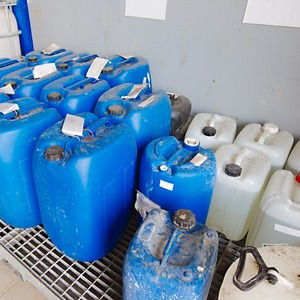The SDS Form
Section 9. Physical and Chemical Properties
This section identifies physical and chemical properties associated with the substance or mixture. These properties include:
- Appearance (physical state, color etc.)
- Upper/Lower flammability or explosive units
- Odor
- Vapor pressure
- Odor threshold
- Vapor density
- pH
- Relative density
- Melting/freezing point
- Solubility(ies)
- Initial boiling point & boiling range
- Flash point
- Evaporation rate
- Flammability (solid, gas)
- Partition coefficient: n-octanol/water - the n-octanol/water partition coefficient (Pₒw) indicates how much of the substance dissolves in n-octanol compared to water.
- Auto-ignition temperature
- Viscosity

Section 10. Stability and Reactivity
This section describes the reactivity hazards of the chemical and the chemical stability information. This section is broken into three parts:
- Reactivity: Description of the specific test data for the chemical(s).
- Chemical stability: Indication of whether the chemical is stable or unstable under normal temperature and conditions. Description of any stabilizers. Indication of any safety issues should the product change in physical appearance.
- Other: Indication of the possibility of hazardous reactions and conditions under which hazardous reactions may occur. List of all conditions that should be avoided. List of all classes of incompatible materials. List of any known or anticipated hazardous decomposition products.
Section 11. Toxicological Information
This section identifies toxicological and health effects information or indicates that such data are not available. This section identifies:
- Information on the likely routes of exposure. The SDS should indicate if the information is unknown.
- Description of the delayed, immediate, or chronic effects from short- and long-term exposure.
- The numerical measures of toxicity - the estimated amount of a substance expected to kill 50% of test animals in a single dose (LD50).
- Description of the symptoms. This description includes the symptoms associated with exposure to the chemical including symptoms from the lowest to the most severe exposure.
- Indication of whether the chemical is a potential carcinogen.
Sections 12-15 - Note: OSHA does not enforce Sections 12 through 15 because other agencies regulate this information.
Section 16: Other Information
This section indicates when the SDS was prepared or when the last known revision was made. It may also highlight what changes have been made compared to the previous version. You may wish to contact the supplier for an explanation of the changes. Additional helpful information might also be found in this section.
Knowledge Check Choose the best answer for the question.
2-4. What SDS section identifies toxicity and health effects?
You forgot to answer the question!
